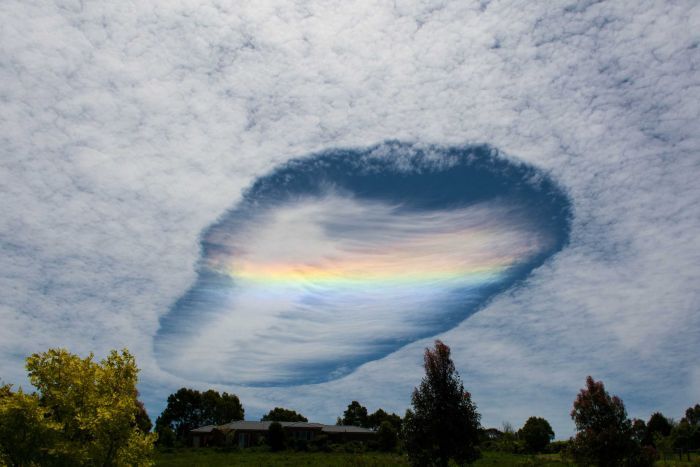‘Rapture’ Cloud Over Australia – Fallstreak Hole
By Philip Ross
A cloud that appeared in the sky over southeast Australia caused a stir on social media Tuesday after photos of the bizarre formation were posted all over Twitter and Instagram. The formation, which Internet users quickly labeled the “rapture” cloud, appeared a day earlier like a giant footprint over the seaside town of Wonthaggi, about 132 kilometers (82 miles) from Melbourne, in the state of Victoria.

Some explanations for the rare sight included aliens, paranormal activity and even an act of God. But believers in the supernatural might be disappointed to know that there was a perfectly logical explanation for the phenomenon, according to scientists. “It looks like a fallstreak cloud,” Michael Efron, a weather forecaster with Australia’s Bureau of Meteorology, told Fairfax Media. Fallstreak clouds, also known as hold punch clouds, are large, circular or elliptical gaps that appear in cloud cover. “They form when the water temperature in the cloud is below freezing, but the water has not yet frozen due to a lack of ice nucleation particles,” Efron said.
https://twitter.com/feed_the_chooks/status/529143381679562752
Hole-punch cloud. Supercooled water drops suddenly freeze often triggered by jets RT @JOSE97LUIS: how does this form? pic.twitter.com/xcpLnrwHLs
— John Morales (@JohnMoralesTV) November 4, 2014
From Wikipedia
A fallstreak hole, also known as a hole punch cloud, punch hole cloud, skypunch, canal cloud or cloud hole, is a large circular or elliptical gap that can appear in cirrocumulus or altocumulus clouds. Such holes are formed when the water temperature in the clouds is below freezing but the water has not frozen yet due to the lack of ice nucleation particles (see supercooled water). When ice crystals do form it will set off a domino effect, due to the Bergeron process, causing the water droplets around the crystals to evaporate: this leaves a large, often circular, hole in the cloud.
It is believed that the introduction of large numbers of tiny ice crystals into the cloud layer sets off this domino effect of evaporation which creates the hole. The ice crystals can be formed by passing aircraft which often have a large reduction in pressure behind the wing- or propellor-tips. This cools the air very quickly, and can produce a ribbon of ice crystals trailing in the aircraft’s wake. These ice crystals find themselves surrounded by droplets, grow quickly by the Bergeron process, causing the droplets to evaporate and creating a hole with brush-like streaks of ice crystals below it. The articles by Westbrook and Davies (2010) and Heymsfield et al. (2010) explain the process in more detail, and show some observations of their microphysics and dynamics. Such clouds are not unique to any one geographic area and have been photographed from many places.
Because of their rarity and unusual appearance, as well as very little exposure in media, fallstreak holes are often mistaken for or attributed to unidentified flying objects.
